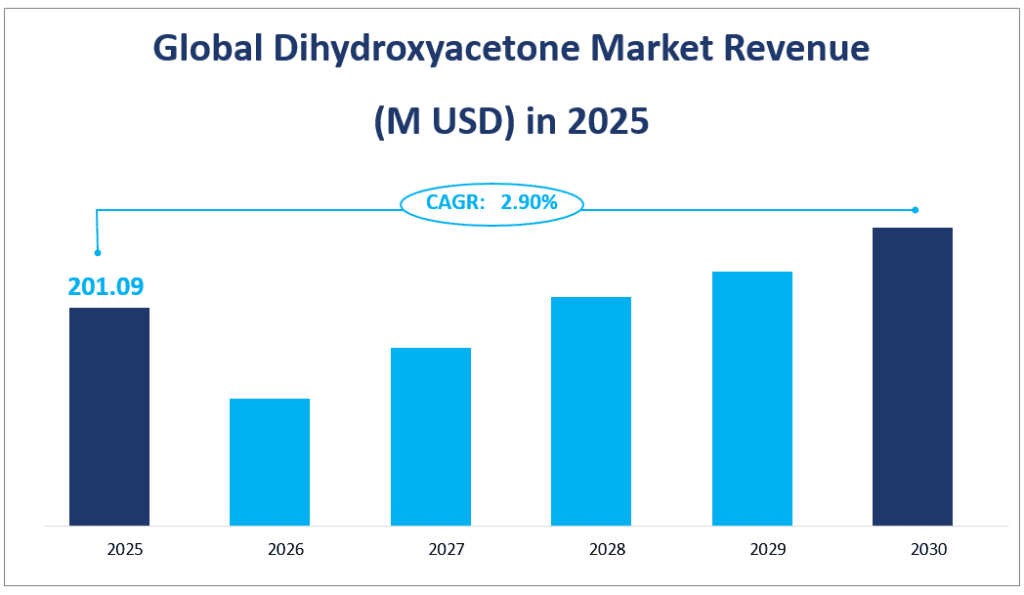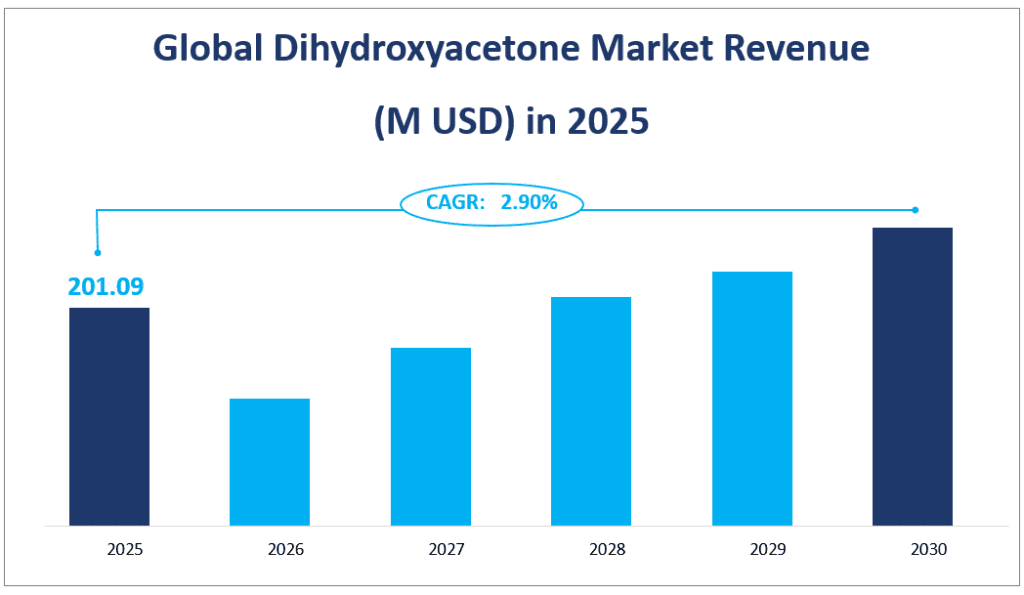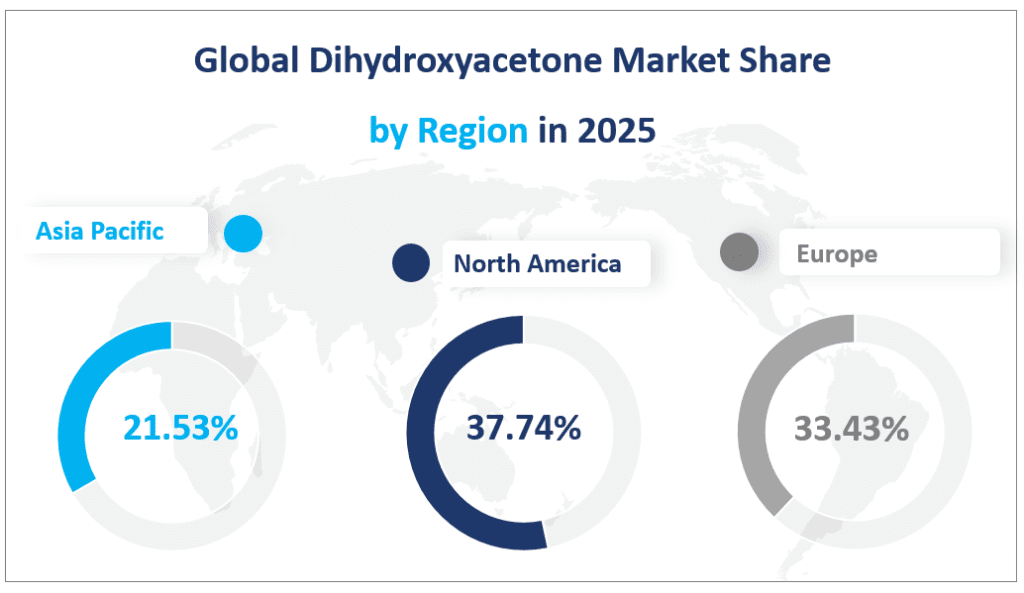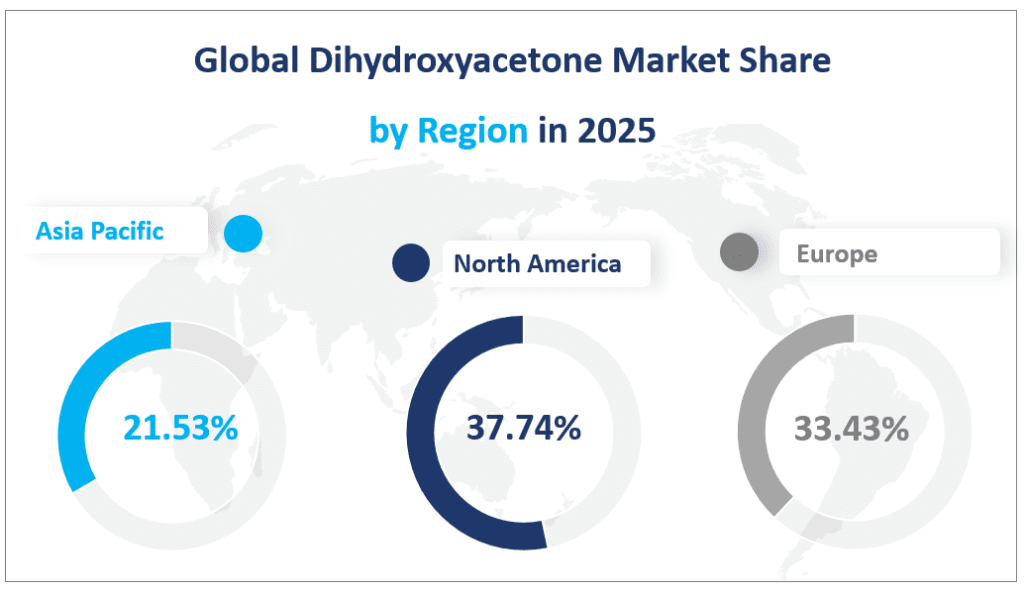1. Global Dihydroxyacetone Market Definition
The global Dihydroxyacetone (CAS 96-26-4) market is projected to reach a value of $201.09 million in 2025 with a CAGR of 2.90% from 2025 to 2030.
Dihydroxyacetone (DHA) is an organic compound with the molecular formula C₃H₆O₃. It is a polyhydroxy ketose and the simplest ketose, characterized by its white powdery crystalline appearance. DHA is highly soluble in organic solvents such as water, ethanol, ether, and acetone, with a melting point of 75-80°C and water solubility exceeding 250g/L at 20°C. This compound has a sweet, cooling taste and a distinctive odor. Dihydroxyacetone is a metabolite with antifungal properties and is used in various industrial applications due to its unique chemical structure and reactivity.
In the cosmetics industry, DHA is a key ingredient in sunless tanning products, providing a safe alternative to UV exposure for achieving a tanned appearance. It reacts with amino acids in the skin to produce a brown pigment, mimicking the effects of sun exposure without the associated health risks. Additionally, DHA is used in the chemical industry as a raw material for polymerization and condensation reactions, in the medical industry as a pharmaceutical intermediate, and in the food industry as a functional additive with potential health benefits, such as increasing metabolic rates and reducing body fat.
Global Dihydroxyacetone Market Revenue (M USD) in 2025


2. Driving Factors of Dihydroxyacetone Market
Increasing Demand from the Cosmetics Industry: The primary driver of Dihydroxyacetone market growth is the rising demand from the cosmetics industry. As consumers become more health-conscious and seek safer alternatives to sun tanning, the popularity of sunless tanning products containing DHA continues to soar. The compound’s ability to provide a natural-looking tan without UV exposure aligns with global trends toward healthier beauty routines.
Regulatory Approvals and Safety: Dihydroxyacetone has received regulatory approvals from major authorities such as the U.S. Food and Drug Administration (FDA), Health Canada, and the European Commission. These endorsements have bolstered consumer confidence and expanded the market’s reach, particularly in the cosmetics sector.
Technological Advancements: Advances in production technology have made the synthesis of Dihydroxyacetone more efficient and cost-effective. Innovations in microbial fermentation techniques, for instance, have reduced production costs while maintaining high product quality. This has made DHA more accessible to a broader range of industries, thereby driving market growth.
Health and Wellness Trends: The global trend towards health and wellness has positively impacted the Dihydroxyacetone market. Consumers are increasingly aware of the potential health risks associated with UV exposure and are seeking safer alternatives. DHA-based products offer a viable solution, contributing to the market’s expansion.
3. Limiting Factors of Dihydroxyacetone Market
Stringent Regulations: While regulatory approvals have been beneficial, the increasing stringency of regulations in some regions poses a challenge. For example, the European Commission’s revision of EU cosmetics regulations in October 2020 imposed limits on the concentration of DHA in certain products. Such regulations can restrict market growth by limiting the scope of product formulations and applications.
High Production Costs: Despite technological advancements, the production of Dihydroxyacetone remains relatively expensive. High raw material costs and complex synthesis processes contribute to elevated production expenses. This can limit the market’s growth by making DHA less accessible to smaller manufacturers and emerging markets.
Market Saturation: In some developed regions, the market for Dihydroxyacetone may be approaching saturation. As demand stabilizes, growth opportunities may become more limited, requiring companies to seek new markets or applications to sustain expansion.
Consumer Awareness and Acceptance: While consumer awareness of the benefits of DHA is growing, there remains a segment of the population that is either unaware of its advantages or skeptical of its safety. This can hinder market penetration and slow overall growth.
4. Analysis of Dihydroxyacetone Market Segment
Microbial Fermentation dominates the Dihydroxyacetone market, accounting for over 91.83% with a market value of $184.66 million in 2025. Microbial fermentation yields high concentrations of DHA, making it an efficient production method. This method is generally more cost-effective compared to chemical synthesis, allowing for larger-scale production at lower costs. Microbial fermentation aligns with growing consumer and regulatory demands for sustainable and eco-friendly production processes.
The fastest-growing product type is Microbial Fermentation. This growth rate is significantly higher than that of Chemical Synthesis. The rapid growth of microbial fermentation can be attributed to its scalability and adaptability to increasing market demands. As the market for DHA expands, particularly in the cosmetics and pharmaceutical industries, microbial fermentation is poised to capture a larger share due to its efficiency and sustainability.
Analysis of Different Applications
The cosmetic industry is the largest application segment for Dihydroxyacetone (DHA), accounting for nearly 46.15% of the total market value in 2025. DHA is a key ingredient in sunless tanning products, providing a safe and effective alternative to UV exposure. Its ability to react with skin proteins to produce a natural-looking tan has driven its widespread adoption. The growth of the cosmetic industry, coupled with increasing consumer awareness of the risks associated with UV exposure, has fueled the demand for DHA-based products.
The chemical industry is the second-largest application segment, with a market value of $32.22 million in 2025. DHA is used as a versatile chemical intermediate in various polymerization and condensation reactions. Its unique chemical properties make it an essential component in the synthesis of specialty chemicals, contributing to its market value.
The medical industry accounts for 26.01% of the DHA market value in 2025. DHA is used as a pharmaceutical intermediate in the synthesis of drugs, particularly those targeting cardiovascular diseases. Its role as an antifungal agent and metabolite also contributes to its demand in the medical sector.
The food industry represents a smaller but significant application segment, with a market value of $14.10 million in 2025. DHA is used as a functional food additive, known for its potential health benefits, such as increasing metabolic rates and reducing body fat. Its use in preserving fruits, vegetables, and meat products also contributes to its market value.
Market Value and Share by Segment
| Market Value (M USD) in 2025 | Market Share in 2025 | ||
| By Type | Chemical Synthesis | 16.43 | 8.17% |
| Microbial Fermentation | 184.66 | 91.83% | |
| By Application | Cosmetic Industry | 92.81 | 46.15% |
| Chemical Industry | 32.22 | 16.02% | |
| Medical Industry | 52.31 | 26.01% | |
| Food Industry | 14.10 | 7.01% |
5. Regional Dihydroxyacetone Market
North America is the largest regional market for Dihydroxyacetone, accounting for nearly 37.74% of the total market value in 2025. This region’s dominance is driven by the United States and Canada, both of which have robust cosmetic and pharmaceutical industries. The high demand for DHA in sunless tanning products and its use as a pharmaceutical intermediate contribute significantly to the region’s market value.
Europe is the second-largest regional market, with a projected value of $67.23 million in 2025. The region’s market share is 33.43%. Europe’s strong cosmetics industry, particularly in countries like France, Germany, and the UK, drives the demand for DHA. The region’s stringent regulatory environment ensures high product standards, further bolstering consumer confidence in DHA-based products.
The Asia Pacific region is the fastest-growing market. This region’s market value is projected to reach $43.30 million in 2025, accounting for 21.53% of the global market. The rapid growth is driven by emerging economies like China and India, where the cosmetics and pharmaceutical industries are expanding rapidly. Additionally, increasing consumer awareness of health and wellness trends is driving demand for DHA-based products.
South America’s market value is projected to reach $7.77 million in 2025. Brazil and Argentina are the key markets in this region, driven by their growing cosmetics and chemical industries. The region’s market share is relatively small at 3.86%, but its growth rate indicates significant potential for expansion.
The Middle East and Africa region has a projected market value of $6.90 million in 2025. The region’s market share is 3.43%, driven by countries like the UAE and South Africa. The demand for DHA in this region is primarily driven by the cosmetics and food industries, with increasing consumer awareness of health and wellness trends.
Global Dihydroxyacetone Market Share by Region in 2025


6. Top 3 Companies in the Dihydroxyacetone Market
Introduction and Business Overview:
Givaudan is a Swiss multinational manufacturer of flavors, fragrances, and active cosmetic ingredients. Established in 1895, Givaudan operates worldwide and is known for its high-quality products and innovative solutions. The company’s products are used in various industries, including food and beverage, household goods, personal care, and perfumes.
Products Offered:
Givaudan offers a range of Dihydroxyacetone (DHA) products, primarily for the cosmetic industry. Their flagship product, Vegetan® DHA, is a pure DHA powder obtained through fermentation using renewable resources. This product is used in sunless tanning products, providing a natural and water-resistant tan.
In 2021, Givaudan’s sales revenue from DHA products was approximately $24.00 million.
Introduction and Business Overview:
Merck KGaA is a German multinational technology company, established in 1668. It is one of the oldest chemical and pharmaceutical companies in the world. The company operates in three main business lines: Healthcare, Life Sciences, and Electronics. Merck KGaA is known for its high-quality products and innovative solutions in the chemical and pharmaceutical sectors.
Products Offered:
Merck KGaA offers Dihydroxyacetone (DHA) products primarily for the cosmetic industry. Their product, 110150 Dihydroxyacetone extra pure, is used in sunless tanning products. This product provides a noticeable and healthy-looking tan within a few hours, lasting up to two weeks.
In 2021, Merck KGaA’s sales revenue from DHA products was approximately $19.85 million.
Introduction and Business Overview:
Spec-Chem Industry is a Chinese high-tech enterprise, established in 1995. The company focuses on the research and development, production, trading, and investment of cosmetics and personal care products. Spec-Chem Industry is a leading supplier of high-end raw materials in the cosmetics and personal care sectors.
Products Offered:
Spec-Chem Industry offers a range of Dihydroxyacetone (DHA) products, primarily for the cosmetic industry. Their flagship product, Tanbest® DHA, is a safe sunless skin-tanning product derived from plant sources such as sugar beets and sugar cane. This product reacts with free amino groups in the skin to produce a natural-looking tan.
In 2021, Spec-Chem Industry’s sales revenue from DHA products was approximately $22.71 million.
Major Players
| Company Name | Headquarters | Market Distribution |
| Givaudan | Switzerland | Worldwide |
| Merck KGaA | Germany | Worldwide |
| Spec-Chem Industry | China | Worldwide |
| Hubei Marvel-Bio Medicine | China | Worldwide |
| Hungsun Chemical | China | Mainly in Asia, Europe, North America |
| Huateng Pharma | China | Worldwide |
| Inoue Perfumery | Japan | Mainly in Asia, Europe, America |
| Changxing Pharmaceutical | China | Mainly in Asia |
| Huaji Biotechnology | China | Worldwide |
| BOC Sciences | USA | Worldwide |
| Biosynth-Carbosynth | Switzerland | Mainly in Europe, Asia, North America |
1 Dihydroxyacetone (CAS 96-26-4) Market Definition and Overview
1.1 Objectives of the Study
1.2 Overview of Dihydroxyacetone (CAS 96-26-4)
1.3 Dihydroxyacetone (CAS 96-26-4) Market Scope and Market Size Estimation
1.4 Market Segmentation
1.4.1 Types of Dihydroxyacetone (CAS 96-26-4)
1.4.2 Applications of Dihydroxyacetone (CAS 96-26-4)
1.5 Market Exchange Rate
2 Research Method and Logic
2.1 Methodology
2.2 Research Data Source
2.2.1 Secondary Data
2.2.2 Primary Data
2.2.3 Market Size Estimation
2.2.4 Legal Disclaimer
3 Market Competition Analysis
3.1 Givaudan Market Performance Analysis
3.1.1 Givaudan Basic Information
3.1.2 Product and Service Analysis
3.1.3 Givaudan Sales, Value, Price, Gross Margin 2016-2021
3.2 Merck KGaA Market Performance Analysis
3.2.1 Merck KGaA Basic Information
3.2.2 Product and Service Analysis
3.2.3 Merck KGaA Sales, Value, Price, Gross Margin 2016-2021
3.3 Spec-Chem Industry Market Performance Analysis
3.3.1 Spec-Chem Industry Basic Information
3.3.2 Product and Service Analysis
3.3.3 Spec-Chem Industry Sales, Value, Price, Gross Margin 2016-2021
3.4 Hubei Marvel-Bio Medicine Market Performance Analysis
3.4.1 Hubei Marvel-Bio Medicine Basic Information
3.4.2 Product and Service Analysis
3.4.3 Hubei Marvel-Bio Medicine Sales, Value, Price, Gross Margin 2016-2021
3.5 Hungsun Chemical Market Performance Analysis
3.5.1 Hungsun Chemical Basic Information
3.5.2 Product and Service Analysis
3.5.3 Hungsun Chemical Sales, Value, Price, Gross Margin 2016-2021
3.6 Huateng Pharma Market Performance Analysis
3.6.1 Huateng Pharma Basic Information
3.6.2 Product and Service Analysis
3.6.3 Huateng Pharma Sales, Value, Price, Gross Margin 2016-2021
3.7 Inoue Perfumery Market Performance Analysis
3.7.1 Inoue Perfumery Basic Information
3.7.2 Product and Service Analysis
3.7.3 Inoue Perfumery Sales, Value, Price, Gross Margin 2016-2021
3.8 Changxing Pharmaceutical Market Performance Analysis
3.8.1 Changxing Pharmaceutical Basic Information
3.8.2 Product and Service Analysis
3.8.3 Changxing Pharmaceutical Sales, Value, Price, Gross Margin 2016-2021
3.9 Huaji Biotechnology Market Performance Analysis
3.9.1 Huaji Biotechnology Basic Information
3.9.2 Product and Service Analysis
3.9.3 Huaji Biotechnology Sales, Value, Price, Gross Margin 2016-2021
3.10 BOC Sciences Market Performance Analysis
3.10.1 BOC Sciences Basic Information
3.10.2 Product and Service Analysis
3.10.3 BOC Sciences Sales, Value, Price, Gross Margin 2016-2021
3.11 Biosynth-Carbosynth Market Performance Analysis
3.11.1 Biosynth-Carbosynth Basic Information
3.11.2 Product and Service Analysis
3.11.3 Biosynth-Carbosynth Sales, Value, Price, Gross Margin 2016-2021
4 Market Segment by Type, Historical Data and Market Forecasts
4.1 Global Dihydroxyacetone (CAS 96-26-4) Production and Value by Type
4.1.1 Global Dihydroxyacetone (CAS 96-26-4) Production by Type 2016-2021
4.1.2 Global Dihydroxyacetone (CAS 96-26-4) Market Value by Type 2016-2021
4.2 Global Dihydroxyacetone (CAS 96-26-4) Market Production, Value and Growth Rate by Type 2016-2021
4.2.1 Chemical Synthesis — Market Production, Value and Growth Rate
4.2.2 Microbial Fermentation — Market Production, Value and Growth Rate
4.3 Global Dihydroxyacetone (CAS 96-26-4) Production and Value Forecast by Type
4.3.1 Global Dihydroxyacetone (CAS 96-26-4) Production Forecast by Type 2021-2026
4.3.2 Global Dihydroxyacetone (CAS 96-26-4) Market Value Forecast by Type 2021-2026
4.4 Global Dihydroxyacetone (CAS 96-26-4) Market Production, Value and Growth Rate by Type Forecast 2021-2026
4.4.1 Chemical Synthesis — Market Production, Value and Growth Rate Forecast
4.4.2 Microbial Fermentation — Market Production, Value and Growth Rate Forecast
5 Market Segment by Application, Historical Data and Market Forecasts
5.1 Global Dihydroxyacetone (CAS 96-26-4) Consumption and Value by Application
5.1.1 Global Dihydroxyacetone (CAS 96-26-4) Consumption by Application 2016-2021
5.1.2 Global Dihydroxyacetone (CAS 96-26-4) Market Value by Application 2016-2021
5.2 Global Dihydroxyacetone (CAS 96-26-4) Market Consumption, Value and Growth Rate by Application 2016-2021
5.2.1 Cosmetic Industry — Market Consumption, Value and Growth Rate
5.2.2 Chemical Industry — Market Consumption, Value and Growth Rate
5.2.3 Medical Industry — Market Consumption, Value and Growth Rate
5.2.4 Food Industry — Market Consumption, Value and Growth Rate
5.3 Global Dihydroxyacetone (CAS 96-26-4) Consumption and Value Forecast by Application
5.3.1 Global Dihydroxyacetone (CAS 96-26-4) Consumption Forecast by Application 2021-2026
5.3.2 Global Dihydroxyacetone (CAS 96-26-4) Market Value Forecast by Application 2021-2026
5.4 Global Dihydroxyacetone (CAS 96-26-4) Market Consumption, Value and Growth Rate by Application Forecast 2021-2026
5.4.1 Cosmetic Industry — Market Consumption, Value and Growth Rate Forecast
5.4.2 Chemical Industry — Market Consumption, Value and Growth Rate Forecast
5.4.3 Medical Industry — Market Consumption, Value and Growth Rate Forecast
5.4.4 Food Industry — Market Consumption, Value and Growth Rate Forecast
6 Global Dihydroxyacetone (CAS 96-26-4) by Region, Historical Data and Market Forecasts
6.1 Global Dihydroxyacetone (CAS 96-26-4) Sales by Region 2016-2021
6.2 Global Dihydroxyacetone (CAS 96-26-4) Market Value by Region 2016-2021
6.3 Global Dihydroxyacetone (CAS 96-26-4) Market Sales, Value and Growth Rate by Region 2016-2021
6.3.1 North America
6.3.2 Europe
6.3.3 Asia Pacific
6.3.4 South America
6.3.5 Middle East and Africa
6.4 Global Dihydroxyacetone (CAS 96-26-4) Sales Forecast by Region 2021-2026
6.5 Global Dihydroxyacetone (CAS 96-26-4) Market Value Forecast by Region 2021-2026
6.6 Global Dihydroxyacetone (CAS 96-26-4) Market Sales, Value and Growth Rate Forecast by Region 2021-2026
6.6.1 North America
6.6.2 Europe
6.6.3 Asia Pacific
6.6.4 South America
6.6.5 Middle East and Africa
7 United State Market Size Analysis 2016-2026
7.1 United State Dihydroxyacetone (CAS 96-26-4) Value and Market Growth 2016-2021
7.2 United State Dihydroxyacetone (CAS 96-26-4) Sales and Market Growth 2016-2021
7.3 United State Dihydroxyacetone (CAS 96-26-4) Market Value Forecast 2021-2026
8 Canada Market Size Analysis 2016-2026
8.1 Canada Dihydroxyacetone (CAS 96-26-4) Value and Market Growth 2016-2021
8.2 Canada Dihydroxyacetone (CAS 96-26-4) Sales and Market Growth 2016-2021
8.3 Canada Dihydroxyacetone (CAS 96-26-4) Market Value Forecast 2021-2026
9 Germany Market Size Analysis 2016-2026
9.1 Germany Dihydroxyacetone (CAS 96-26-4) Value and Market Growth 2016-2021
9.2 Germany Dihydroxyacetone (CAS 96-26-4) Sales and Market Growth 2016-2021
9.3 Germany Dihydroxyacetone (CAS 96-26-4) Market Value Forecast 2021-2026
10 UK Market Size Analysis 2016-2026
10.1 UK Dihydroxyacetone (CAS 96-26-4) Value and Market Growth 2016-2021
10.2 UK Dihydroxyacetone (CAS 96-26-4) Sales and Market Growth 2016-2021
10.3 UK Dihydroxyacetone (CAS 96-26-4) Market Value Forecast 2021-2026
11 France Market Size Analysis 2016-2026
11.1 France Dihydroxyacetone (CAS 96-26-4) Value and Market Growth 2016-2021
11.2 France Dihydroxyacetone (CAS 96-26-4) Sales and Market Growth 2016-2021
11.3 France Dihydroxyacetone (CAS 96-26-4) Market Value Forecast 2021-2026
12 Italy Market Size Analysis 2016-2026
12.1 Italy Dihydroxyacetone (CAS 96-26-4) Value and Market Growth 2016-2021
12.2 Italy Dihydroxyacetone (CAS 96-26-4) Sales and Market Growth 2016-2021
12.3 Italy Dihydroxyacetone (CAS 96-26-4) Market Value Forecast 2021-2026
13 Spain Market Size Analysis 2016-2026
13.1 Spain Dihydroxyacetone (CAS 96-26-4) Value and Market Growth 2016-2021
13.2 Spain Dihydroxyacetone (CAS 96-26-4) Sales and Market Growth 2016-2021
13.3 Spain Dihydroxyacetone (CAS 96-26-4) Market Value Forecast 2021-2026
14 Russia Market Size Analysis 2016-2026
14.1 Russia Dihydroxyacetone (CAS 96-26-4) Value and Market Growth 2016-2021
14.2 Russia Dihydroxyacetone (CAS 96-26-4) Sales and Market Growth 2016-2021
14.3 Russia Dihydroxyacetone (CAS 96-26-4) Market Value Forecast 2021-2026
15 China Market Size Analysis 2016-2026
15.1 China Dihydroxyacetone (CAS 96-26-4) Value and Market Growth 2016-2021
15.2 China Dihydroxyacetone (CAS 96-26-4) Sales and Market Growth 2016-2021
15.3 China Dihydroxyacetone (CAS 96-26-4) Market Value Forecast 2021-2026
16 Japan Market Size Analysis 2016-2026
16.1 Japan Dihydroxyacetone (CAS 96-26-4) Value and Market Growth 2016-2021
16.2 Japan Dihydroxyacetone (CAS 96-26-4) Sales and Market Growth 2016-2021
16.3 Japan Dihydroxyacetone (CAS 96-26-4) Market Value Forecast 2021-2026
17 South Korea Market Size Analysis 2016-2026
17.1 South Korea Dihydroxyacetone (CAS 96-26-4) Value and Market Growth 2016-2021
17.2 South Korea Dihydroxyacetone (CAS 96-26-4) Sales and Market Growth 2016-2021
17.3 South Korea Dihydroxyacetone (CAS 96-26-4) Market Value Forecast 2021-2026
18 Australia Market Size Analysis 2016-2026
18.1 Australia Dihydroxyacetone (CAS 96-26-4) Value and Market Growth 2016-2021
18.2 Australia Dihydroxyacetone (CAS 96-26-4) Sales and Market Growth 2016-2021
18.3 Australia Dihydroxyacetone (CAS 96-26-4) Market Value Forecast 2021-2026
19 India Market Size Analysis 2016-2026
19.1 India Dihydroxyacetone (CAS 96-26-4) Value and Market Growth 2016-2021
19.2 India Dihydroxyacetone (CAS 96-26-4) Sales and Market Growth 2016-2021
19.3 India Dihydroxyacetone (CAS 96-26-4) Market Value Forecast 2021-2026
20 Brazil Market Size Analysis 2016-2026
20.1 Brazil Dihydroxyacetone (CAS 96-26-4) Value and Market Growth 2016-2021
20.2 Brazil Dihydroxyacetone (CAS 96-26-4) Sales and Market Growth 2016-2021
20.3 Brazil Dihydroxyacetone (CAS 96-26-4) Market Value Forecast 2021-2026
21 Argentina Market Size Analysis 2016-2026
21.1 Argentina Dihydroxyacetone (CAS 96-26-4) Value and Market Growth 2016-2021
21.2 Argentina Dihydroxyacetone (CAS 96-26-4) Sales and Market Growth 2016-2021
21.3 Argentina Dihydroxyacetone (CAS 96-26-4) Market Value Forecast 2021-2026
22 Chile Market Size Analysis 2016-2026
22.1 Chile Dihydroxyacetone (CAS 96-26-4) Value and Market Growth 2016-2021
22.2 Chile Dihydroxyacetone (CAS 96-26-4) Sales and Market Growth 2016-2021
22.3 Chile Dihydroxyacetone (CAS 96-26-4) Market Value Forecast 2021-2026
23 South Africa Market Size Analysis 2016-2026
23.1 South Africa Dihydroxyacetone (CAS 96-26-4) Value and Market Growth 2016-2021
23.2 South Africa Dihydroxyacetone (CAS 96-26-4) Sales and Market Growth 2016-2021
23.3 South Africa Dihydroxyacetone (CAS 96-26-4) Market Value Forecast 2021-2026
24 Egypt Market Size Analysis 2016-2026
24.1 Egypt Dihydroxyacetone (CAS 96-26-4) Value and Market Growth 2016-2021
24.2 Egypt Dihydroxyacetone (CAS 96-26-4) Sales and Market Growth 2016-2021
24.3 Egypt Dihydroxyacetone (CAS 96-26-4) Market Value Forecast 2021-2026
25 UAE Market Size Analysis 2016-2026
25.1 UAE Dihydroxyacetone (CAS 96-26-4) Value and Market Growth 2016-2021
25.2 UAE Dihydroxyacetone (CAS 96-26-4) Sales and Market Growth 2016-2021
25.3 UAE Dihydroxyacetone (CAS 96-26-4) Market Value Forecast 2021-2026
26 Saudi Arabia Market Size Analysis 2016-2026
26.1 Saudi Arabia Dihydroxyacetone (CAS 96-26-4) Value and Market Growth 2016-2021
26.2 Saudi Arabia Dihydroxyacetone (CAS 96-26-4) Sales and Market Growth 2016-2021
26.3 Saudi Arabia Dihydroxyacetone (CAS 96-26-4) Market Value Forecast 2021-2026
27 Market Dynamic Analysis and Development Suggestions
27.1 Market Drivers
27.2 Market Development Constraints
27.3 PEST Analysis
27.3.1 Political Factors
27.3.2 Economic Factors
27.3.3 Social Factors
27.3.4 Technological Factors
27.4 Industry Trends Under COVID-19
27.4.1 Risk Assessment on COVID-19
27.4.2 Assessment of the Overall Impact of COVID-19 on the Industry
27.4.3 Pre COVID-19 and Post COVID-19 Market Scenario
27.5 Market Entry Strategy Analysis
27.5.1 Market Definition
27.5.2 Client
27.5.3 Distribution Model
27.5.4 Product Messaging and Positioning
27.5.5 Price
27.6 Advice on Entering the Market
